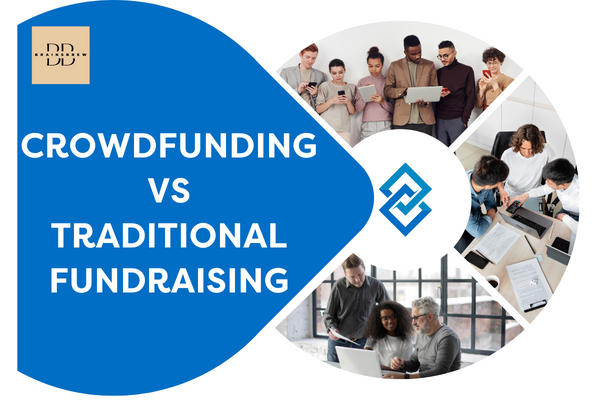You must first secure funding to start a business or produce anything in the financial world. That’s the most basic and essential part. Earlier, the means of funding needed to be narrower. But, due to various developments, entrepreneurs or people can raise money directly from the crowd.
So, if you want to secure money for any idea, you should have a clear idea of crowdfunding and traditional fundraising and their pros and cons!
What is Crowdfunding?

Crowdfunding is a type of funding that happens when you raise small amounts of money from many people. Crowdfunding happens on different platforms, where the crowd can see a person’s idea and decide if they want to raise funds for it.
Crowdfunding projects typically include startup businesses, creative ventures like film and game production, and charitable undertakings. The people funding the projects do not expect a financial return if they are not “equity-based crowdfunding.”
What is Traditional Fundraising?

Traditional fundraising is the popular form of raising capital for a venture by pitching business ideas to investors, capitalists, and financial institutions like banks. These people or organizations are established, and if they take an interest in or see potential in your project, they can offer funds or give out loans to develop your idea.
Differences Between Crowdfunding and Traditional Fundraising
Even though both of the funding approaches help raise capital, they are different from each other. Crowdfunding and traditional fundraising are two distinct approaches to raising capital that depend upon your project’s goal, development stage, management, and other factors. Here are the points that make them distinguishable:
1. Source of funds
The main difference between crowdfunding and traditional fundraising methods is how one secures their funding.
Traditional fundraising can happen through several different methods, like banks, angelinvestors, and venture capitalists.
Crowdfunding is the collection of funds received from a large group of people. It mostly happens through online crowdfunding sites like Kickstarter and GoFundMe.
2. Speed
Among the best advantages of crowdfunding is how fast it works compared to traditional fundraising methods. Traditional methods include pitching to investors, capitalists, banks, and other financial institutions. These mediums require a lot of paperwork, different schedules for various meetings, and similar tasks, which can slow the process.
On the other hand, crowdfunding for businesses can be simpler and faster because you have to add your proposal to the crowdfunding site once with the necessary information, such as the idea, funding range, and envisioned goal. Once the pitch is successfully published, people, usually from all over the world, can help you fund your goal.
Crowdfunding can also be time-consuming because the field is highly competitive. But it’s still a speedier process compared to traditional funding methods.
A business coach and YouTuber, Salvador Briggman, says that spreading awareness about your campaign is the key to getting fast results. He quotes:
“I believe that my campaign was funded so quickly because I spent a lot of time building an audience for months.”
3. Control
With traditional fundraising, you give up control over making decisions about your idea, as the investors or capitalists will get equity in exchange for funding your project.
Aside from equity-based crowdfunding, crowdfunding doesn’t require giving up control or providing a financial return. The ‘crowd’ backs you up because they are intrigued by your proposal.
4. Platform
In choosing crowdfunding and traditional fundraising, the platform through which you can get the funds plays a big role. Crowdfunding campaigns are run online. They happen on established crowdfunding sites like Kickstarter and Indiegogo.
While traditional fundraising happens through traditional mediums like banks, venture capital, investors, and personal savings, it can also happen online. However, it’s still very true to its nature, i.e., traditional, and thus, most of the meetings happen offline, too.
5. Purpose of funding
Securing funds through traditional fundraising is to start or add to a venture/business. Conversely, crowdfunding has a broader spectrum when it comes to completing the purpose of the funding. Besides business ventures, crowdfunding campaigns are run for entertainment and charitable projects.
Anyone can run to fulfill their dream project. You’ll find that even crowdfunding sites nowadays are filled with different filters to help you navigate if you want to see campaigns for creative projects, startups, philanthropic needs, etc.
Simon Walker, ex-head coach at Crowdfunder and founder of The Prize Draw Company, quotes:
“We do live in a time when there’s distrust in our institutions, and so we should be insisting on the kind of empowerment that crowdfunding can give us. There is inequality and unfairness, so we should be reducing the barriers in the way that crowdfunding can allow us to do that.”
6. Risk of Fraud
Though crowdfunding has advantages, this funding model has a big risk. What is it? People can give out funds by looking at a campaign, but since there is no one to look over the creator, they can mismanage the funds or even run a scam. This affects many crowdfunding sites, causing the community to lose faith.
Traditional fundraising is much more secure because the person with the idea gets the funding through proper paperwork and from established sources, which ensures that their funds are being used in that particular project.
Conclusion
Both crowdfunding and traditional fundraising have pros and cons. Of course, since we live in the 21st century, people like to use crowdfunding campaigns more than traditional fundraising methods. Still, due to the extreme competition nowadays, this type of funding has also become challenging.
Both types of funding have different aims, and you’ll have to decide which is right for you, considering your project’s goals.

